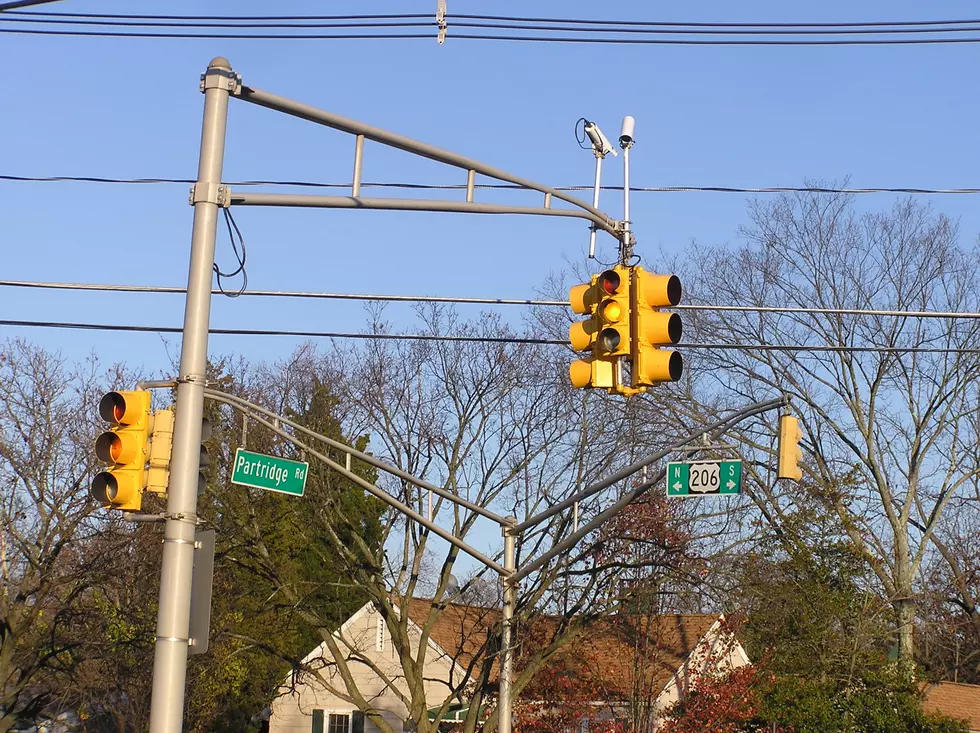![Problems With Speed Tests in Red Light Camera Program, Lawmaker Says [VIDEO]](http://townsquare.media/site/385/files/2012/08/red-light-cams.jpg?w=980&q=75)
Problems With Speed Tests in Red Light Camera Program, Lawmaker Says [VIDEO]
A Garden State lawmaker is calling for New Jersey’s red light camera pilot program to be suspended – for the second time this summer.
The program was given the green light to be restarted eight days ago - after the Jersey Department of Transportation announced yellow light timing issues at dozens of red light camera intersections had been resolved – but new questions are being raised about that decision.
Assemblyman Declan O’Scanlon believes the methodologies used to re-certify all of the traffic lights used at red light camera intersections are unclear, flawed and questionable.
He says the DOT told towns if their yellow light times were not certified they would be thrown out of the red light camera program – and that was “a very big incentive for them to figure out a way to make sure their yellow light times were in conformity – and that’s exactly what happened…but we have heard anecdotal stories from people about the methodology used and we know that it’s faulty.”
were Speed Tests Performed Incorrectly?
O’Scanlon says the timing of many yellow lights may be off because speed tests have been performed incorrectly – since “yellow lights are supposed to be set according to the speeds at which people are actually traveling through these intersections – that’s the only fair way to do it…instead of simply assuming that people are going the speed limit as they approach an intersection with a red light camera, you have to actually take speed studies – take real speed measurements of free-flowing traffic – it does you no good to take speed measurements of traffic that is in a traffic jam - that’s unfair…it seems that many municipalities have used faulty criteria in order to come up with – to be able to certify- or have someone certify that they’re in compliance….there are a dozen ways that you can design a methodology for gauging speeds – and then yellow light times – that would give you a lower speed at a commensurately shorter yellow light time - which –as we know - is not fair to motorists who don’t have the time to clear these intersections.”
The bottom line, says O’Scanlon is “we now know that the methodologies used by many municipalities was flawed and we’re going to collect our own data - we have brought in some certified traffic engineers…our goal is not to come up with a methodology that gets us to our conclusion – our goal is to come up with a fair methodology that arrives at the truth…over the next week or so we’re going to be collecting our own data…we are going to stand up for the motorists of New Jersey who are being treated unfairly by this program - and make sure that is corrected.”
He points out the Governor’s administration has shown every indication that they have that same concern- they want people treated fairly –and “nobody wants anybody going through red lights – we want to cut that down as much as possible – but we also in the process need to make sure that we’re treating people fairly – they are not now- at very likely, many intersections.”
National Motorist Association traffic experts – who are assisting O’Scanlon - say it appears some towns were collecting speed data right at the intersection – either with automated equipment or police in marked cars with radar- so the data they got was not free-flowing – which is what is necessary to accurately determine how fast cars are moving and how long the yellow light should be.
O’Scanlon adds, “we’ve established there is a fair time for a light to be yellow – sound engineering criteria tells you that you have to set a yellow light to a proper time based on people’s speeds- they need a longer yellow light time if they’re approaching an intersection at a higher rate of speed – they need more time to be able to be aware of that and slow down and stop at the intersection – if you shorten your yellow light time you’re going to catch a lot more people and you’re going to catch them unfairly.. that’s what we need to avoid…this program will lose whatever shred of credibility it has left if we don’t’ ensure that.”
He points out that “people already perceive that this program is designed to generate revenue…in the big picture red light cameras do not enhance safety – any objective study done throughout the country has shown
that…if this pilot program is going to continue we need to stop ripping people off…this program is a big enough mess- and this re-certification has been a mess…we now have the data that the DOT got - there was no independent verification of the methodology used by DOT…the certifications are in many instances, one page – simply saying it complies to some standard that is not even outlined in the certifications.”
So what needs to be done to fix the problem?
O’Scanlon says “we ultimately are going to need some legislative redress here – in order to build any credibility back into this pilot program- and we’re looking at a number of options to do that.”
He says legislation is in the pipeline to end the program - which would be the wisest choice, “but we also are looking at legislation that will increase yellow light times – will make it absolutely clear and concise that yellow light times need to be X… it’s vitally important to fix this to communicate to the public that look, we really are not here to rip you off – we really are here to try to do this experiment and see if it results in more safety.”
O’Scanlon believes the criteria used by the DOT for the program is flawed.
“The DOT permitted speed limits to be used in the calculations of what the yellow light time needs to be,” he says, “you use speed limit divided by 10 (so if the speed limit is 40 MPH, the yellow light would be 4 seconds) - that’s flawed because we know for a fact…we know the speed limits are flawed – they do not comport with sound engineering criteria – they’re lower than they’d be otherwise – which results in lower yellow light times…the law- the statute creating this pilot program was very specific – it doesn’t say use speed limit – it specifically says you absolutely have to use the prevailing speeds of approaching traffic.”
He adds “if there are intersections that are out of compliance, that’s a nail in the coffin of the credibility of this program."
On Wednesday, National Motorist Association Foundation traffic experts were not able to take speed measurements – because it was raining – but they say in Gloucester County - on Blackwood-Clementon Road (CR 534) and Blenheim/Erial/New Brooklyn Road (CR 706), the Northbound approach for CR706 has an observed 45 mph speed limit and a measured yellow time of 4 seconds. They say by the NJDOT speed limit timing method, the yellow time should be 5 seconds, or with a 45 mph 85th percentile speed, the minimum yellow time, per the RLC statute, would be 4 and a half seconds. The yellow time for this approach falls short and doesn't meet two specifications.
On Blackwood-Clementon Rd (CR 534) and Little Gloucester Rd (CR 759), the Southbound approach for Little Gloucester has an observed 50 mph speed limit and a measured yellow time of 4 second seconds. They conclude that by the NJDOT speed limit timing method, the yellow time should be 5 seconds. The yellow time for this approach falls short and doesn't meet NJDOT’s yellow timing specification.
Statement From D.O.T.
The law requires towns to conduct a study and submit a certification, and for the Municipal Engineer to submit a certification to the agency. Our role was to review these certifications to see if they meet the language of the law. And we have determined that they do. Our job was not to dissect the methods the towns used to do the new traffic analysis. So, if critics have concerns about how these studies were done, that is an issue they should take up with the towns."
More From New Jersey 101.5 FM









